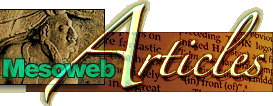

| Tikal: Central Temple of a Row of Seven Temples, East (Rear) Side. Photo by Teobert Maler. |

![]()
![]()
|
The civilization that flourished for at least 1,200 years at the ancient Maya city of Tikal (the original name of which was probably Mutal or Yax Mutal) collapsed, more or less simultaneously with most other important Maya centers of the Classic period, at the end of the ninth century of our era. Even though population gradually ebbed away from this once-mighty urban center, it is not clear whether knowledge of its ruins was ever lost. Guatemalan archives contain references to people living in them during the eighteenth century, and it is even possible that the majestic ruins were visited by a Spanish missionary in 1695. Fray Andrés de Avedaño y Loyola had set out for the island stronghold of Tayasal in Lake Petén Itzá, Guatemala, in an attempt to convert the last independent Maya kingdom to Christianity. The mission was a failure, and on their way home Avedaño and his traveling companions got lost in the swamps and forests of northern Guatemala. Avedaño writes that, dizzy with hunger, they stumbled across a "variety of old buildings, excepting some in which I recognized apartments, and though they were very high and my strength was little, I climbed up them..." John Lloyd Stephens, exploring with Frederick Catherwood in 1839, reports hearing rumors of a living ancient city, the white towers of which could still be seen above the treetops in the middle of the tropical jungle. Be that as it may, Stephens and Catherwood did not visit Tikal in the course of their famous 1839-40 journey, and it was not until 1848 that the first formal expedition in pursuit of the ancient city was conducted under the authority of Modesto Méndez and Ambrosio Tut. Their report, however, was not published until 1853 when it appeared, in German, in a bulletin issued by the Berlin Academy of Science. In 1877 the Swiss Gustav Bernoulli organized a party to go to the city and remove some of the surviving wooden lintels in Temples I and IV. To this day, these lintels can be seen at the Ethnographic Museum in Basel, Switzerland. The first serious archaeological work at the site of Tikal was carried by the Englishman Alfred P. Maudslay, who visited the ruins in 1881 and 1882. His superb recording work (which included clearing vast swaths of forest to free vistas of plazas and temples) was published shortly after the turn of the twentieth century as part of a special section, dedicated to archaeology, of the monumental compendium Biologia Centrali Americana. Shortly after Maudlsay's visits, the Austrian Teobert Maler started work at Tikal. Commissioned by Harvard University's Peabody Museum, he stayed for over three months in the course of two trips to the ruined city in 1895 and 1904. A superb and methodical recorder, his full work, however, was not published by the Peabody, since the irascible Maler quarrelled with the institution and did not turn over some aspects of his work, such as the map he made of the ruins of Tikal. Lacking full documentation, the Peabody was forced to field another expedition, this time under Alfred Tozzer, and ultimately published in 1911 a report that combined Maler's and Tozzer's work. Next, Sylvanus Morley, one of the best-known Mayanists of the twentieth century, conducted work at the site in the course of 1914, 1921, 1922 and 1928 visits. His work was carried out under the auspices of Washington's Carnegie Institution. Morley was particularly interested in the site's inscriptions, for which reason he concentrated his efforts on recording these, publishing them later in his comprehensive Inscriptions of Peten. Between 1956 and 1970, the first large-scale excavation project at Tikal was undertaken by the University Museum of the University of Pennsylvania. Working in close collaboration with the Guatemalan authorities, this project is reponsible for a large part of what we know of the site today, as it not only cleared a sizable sample of the site core's architecture, but also allowed, for the first time, a clear image of the city's growth and development. This large-scale work was supplemented by a detailed publication of its results, including high-quality drawings of monuments which, ultimately, have allowed the epigraphical work that has returned to us the ancient history of the city and its rulers. Starting in 1979 and continuing to the present, the Guatemalan Proyecto Nacional Tikal has continued archaeological work at this magnificent site, being responsible, among other things, for excavations at the all-important Early Classic complex known as the Mundo Perdido or "Lost World".
|